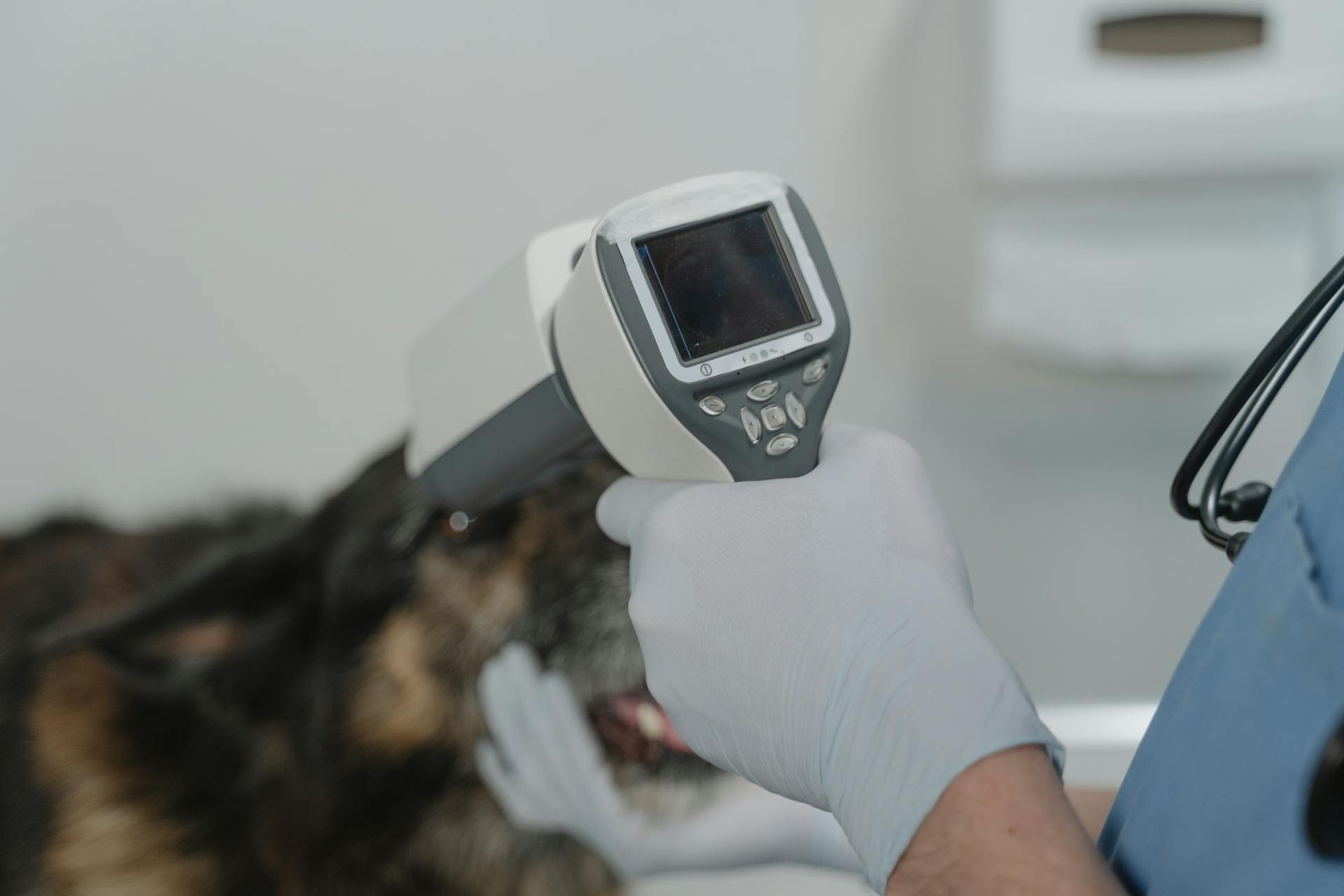
Epilepsy in animals is a neurological disorder that affects millions of pets worldwide. Epilepsy is characterized by recurring seizures, which can be caused by genetic mutations, head trauma, or infections.
Seizures can manifest differently in animals, ranging from mild tremors to full-blown convulsions.
Some breeds are more prone to epilepsy, such as the Labrador Retriever and the Cocker Spaniel.
Symptoms of epilepsy in animals may be subtle, such as changes in behavior or confusion.
Explore further: Epilepsy in Cocker Spaniels
What Is Epilepsy in Animals?
Epilepsy in animals is a neurological disorder that affects the brain's ability to control electrical impulses, leading to seizures. This condition can occur in any animal, regardless of breed or age.
Seizures can manifest differently in animals, ranging from mild tremors to full-blown convulsions. Seizures can also vary in frequency, from occasional episodes to daily occurrences.
Epilepsy can be caused by various factors, including genetics, head trauma, infections, and toxins. In some cases, the underlying cause may be unknown.
Symptoms of epilepsy in animals can be subtle, making diagnosis challenging. Owners may notice changes in behavior, such as confusion, disorientation, or lethargy, before a seizure occurs.
Diagnosing epilepsy in animals typically involves a combination of physical exams, medical history, and diagnostic tests, such as EEGs and imaging studies.
Signs and Characteristics
If your vet suspects that your dog has epilepsy, it's likely because they've had at least two unprovoked seizures more than 24 hours apart.
A seizure can be difficult to diagnose, so it's helpful to provide your vet with a thorough description of the abnormal event, or even a video recording, to aid in the diagnosis.
Seizures can manifest in different ways, but some common characteristics include loss of voluntary control, convulsions (such as jerking or shaking movements and muscle twitching), and irregular attacks that start and finish very suddenly.
A seizure occurs when there's abnormal electrical activity in the brain that leads to sudden but short-lived changes in a dog's behaviour and/or movement.
Some seizures may appear very similar each time and have a repetitive clinical pattern, while others may be unpredictable and varied.
Characteristics of Epileptic
Epileptic seizures can be unpredictable and may start and finish very suddenly. This irregularity can make them difficult to diagnose.
A seizure is characterized by abnormal electrical activity in the brain, which can lead to sudden changes in a dog's behavior and/or movement. This can be a frightening experience for both dog and owner.
One of the most noticeable signs of an epileptic seizure is the loss of voluntary control, often accompanied by convulsions such as jerking or shaking movements and muscle twitching. This is a key indicator that a seizure is taking place.
Epileptic seizures can appear very similar each time and have a repetitive clinical pattern. This can make them easier to identify in the future.
Here are some common characteristics of epileptic seizures:
- Loss of voluntary control, often seen with convulsions (jerking or shaking movements and muscle twitching)
- Irregular attacks that start and finish very suddenly
- Attacks that appear very similar each time and have a repetitive clinical pattern
It's essential to note that seizures can be triggered by various factors, and understanding these characteristics can help you identify potential triggers and take steps to prevent future seizures.
Severity, Frequency, and Length
The severity, frequency, and length of seizures in dogs with epilepsy can vary greatly. Some dogs experience seizures that are very close together in time, which is known as a cluster seizure.

Cluster seizures occur in around ⅓ to ¾ of dogs with idiopathic epilepsy, and some breeds are more prone to them. These breeds include the German Shepherd Dog, Border Collie, Boxer, Cavalier King Charles Spaniel, Staffordshire Bull Terrier, and Labrador Retriever.
Cluster seizures can be life-threatening and an emergency, so it's essential to keep a record of how often your dog has seizures. This will help your vet track how well their treatment is working and make any necessary changes.
A cluster seizure is defined as two or more seizures within a 24-hour period. Emergency medication may be prescribed by your vet for home use to stop the seizure and prevent more from occurring.
If your dog has cluster seizures, it's crucial to contact your vet for further advice and/or changes in treatment to try and avoid clusters occurring in the future.
Status epilepticus is a more severe condition that requires immediate treatment. It's defined as either a seizure that lasts longer than five minutes, or where two or more individual epileptic seizures occur without your dog returning to normal and regaining full consciousness.
Here's a summary of the different types of seizures:
- Cluster seizures: two or more seizures within a 24-hour period
- Status epilepticus: a seizure lasting longer than five minutes, or two or more individual seizures without your dog returning to normal
Types and Causes
There are four common types of seizures that affect dogs: Grand Mal Seizures, Focal Seizures, Psychomotor Seizures, and Idiopathic Epilepsy Seizures. Grand Mal Seizures are the most well-known type, causing total muscle control loss and convulsions.
Some breeds are more prone to epilepsy than others, including German Shepherds, Belgian Tervurens, Australian Shepherds, Labrador Retrievers, Staffordshire Bull Terriers, Golden Retrievers, Beagles, and Collies.
Epilepsy in dogs can be caused by a variety of factors, including low blood sugar, metabolic disorders, heatstroke, lack of oxygen, and liver/kidney failure. In some cases, no underlying cause can be identified, and a genetic predisposition is presumed.
Here are some breeds that are genetically predisposed to epilepsy:
- German shepherd
- Belgian tervuren
- Australian shepherd
- Labrador retriever
- Staffordshire bull terrier
- Golden retriever
- Beagle
- Collie
Types
Types of seizures in dogs and cats can be complex and varied. There are several types of seizures, each with its own unique characteristics.
Focal seizures occur in only one half of the brain and within a particular region, and can present as episodic movements, autonomic signs, or behavioral signs.
Here's an interesting read: Symptoms Diabetes in Dogs

Generalized seizures, on the other hand, occur within both sides of the brain and can cause the dog to lose consciousness, salivate, urinate, and defecate. They can also be non-convulsive, such as atonic seizures, which result in a sudden and general loss of muscle tone.
Some common types of seizures include Grand Mal Seizures, which are typically caused by abnormal electrical activity in the brain and can last a few seconds to a few minutes. Focal Seizures only affect one side or region of the brain, while Psychomotor Seizures can cause a dog to behave oddly, such as running in circles or attempting to bite imaginary objects.
Other types of seizures include Idiopathic Epilepsy Seizures, which are the most common cause of seizures in dogs and are often inherited in certain breeds.
Here's a breakdown of the different types of seizures:
Status Epilepticus Seizures are continuous seizures that last 5-10 minutes or more, and require urgent medical treatment.
What Causes?

Epilepsy in dogs can be caused by a variety of factors. Some breeds are genetically predisposed to epilepsy, including German shepherds, Belgian tervurens, Australian shepherds, and more.
Low blood sugar, metabolic disorders, heatstroke, lack of oxygen, and liver/kidney failure can all cause cell signalling problems in the brain, leading to seizures.
Idiopathic epilepsy is the most common cause of seizures in dogs, and it's a hereditary disorder. Doctors don't yet know the exact cause, but they know that certain breeds are more prone to it.
Some underlying diseases and factors can cause seizures leading to epilepsy. These can be structural, where an underlying cause can be identified in the brain, or idiopathic, where no underlying cause can be identified.
Structural causes of epilepsy can include problems with blood supply, bleeding, inflammation, infection, trauma, developmental problems, brain tumors, and degenerative brain diseases. These abnormalities can be confirmed by MRI and/or cerebrospinal fluid analysis.
Worth a look: Blood Sugar Levels for Dogs with Diabetes

Here are some examples of structural causes of epilepsy:
- Problems with blood supply, such as obstructions
- Bleeding, inflammation, infection, trauma, developmental problems, brain tumors, and degenerative brain diseases
Reactive seizures occur in response to a temporary problem in brain function, which may be a result of metabolic changes or poisoning. Examples of metabolic changes include Addison’s disease, liver disease, portosystemic shunts, and diabetes mellitus.
Expand your knowledge: Dog Metabolic Diseases
Frequently Asked Questions
What are the stages of epilepsy in animals?
The stages of epilepsy in animals include prodrome, aura, ictus, and postictal, with the prodrome being the least consistent stage. Understanding these stages can help identify and manage epilepsy in pets.
What are the effects of epilepsy in animals?
Epilepsy in animals can cause abnormal motor activities, behavioral changes, and autonomic function disruptions, such as seizures, twitches, and vomiting. If you suspect your pet has epilepsy, it's essential to consult a veterinarian for proper diagnosis and treatment.
Sources
- https://www.thekennelclub.org.uk/health-and-dog-care/health/health-and-care/a-z-of-health-and-care-issues/epilepsy/
- https://todaysveterinarypractice.com/nutrition/nutritional-management-of-idiopathic-epilepsy-in-dogs/
- https://en.wikipedia.org/wiki/Epilepsy_in_animals
- https://pureformpethealth.com/blogs/pet-health-conditions-a-z/epilepsy-seizures-causes-symptoms-treatment
- https://www.thesprucepets.com/diagnosing-seizures-in-dogs-and-cats-3384729
Featured Images: pexels.com


